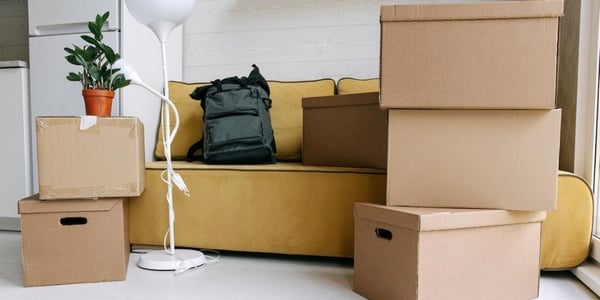With every move, you have to make some serious decisions. In retirement, you need to consider...
8 Storage Option Alternatives To Consider When Downsizing
Whether you're moving out into a smaller place or if your kids have flown the nest, choosing to downsize can be a good decision for various reasons. However, if you're moving from a much larger home into a cozier place, deciding where to store all your belongings can be a problem. Depending on how many items you own, downsizing can be a tough challenge.
Despite the challenges of downsizing, the good news is that there are many storage solutions that will make your life a little easier. Let's look at eight great storage options to consider when downsizing.
Great Storage Alternatives!
1. Self-Storage Units
Self-storage units offer a versatile solution for those navigating the challenges of downsizing. These facilities come in various sizes, from small lockers to spacious rooms, accommodating different storage needs. It's important to consider the security and accessibility of the chosen facility, as reputable ones often provide 24/7 security, climate-controlled units for sensitive items, and flexible access hours. While self-storage is ideal for short-term storage during the downsizing process, it's essential to factor in the long-term costs, as continuously renting a unit can accumulate expenses over time.
Click here to read: Pros and Cons of Renting a Storage Unit When Downsizing!
2. Donate
Donating your belongings during the downsizing process not only helps declutter your living space but also serves a meaningful purpose by benefiting those in need. Organizations like the Salvation Army and Goodwill often provide tax deductions for donated items, making it a financially advantageous choice. However, you should donate only items in good condition to ensure they can be of genuine value to others. Ensure clothing is clean, electronics are functional, and furniture is free of significant damage. Beyond the practical benefits, donating items is also an ethical choice as it promotes sustainability and reduces waste by extending the useful life of items.
3. Sell It
Selling items you no longer need can be rewarding during downsizing. While traditional garage sales are an option, they may require marketing efforts to attract potential buyers. Alternatively, online platforms like Facebook Marketplace, eBay, Poshmark, and ThredUp offer access to a broader audience and provide convenient transaction processes.
However, they may involve shipping or local meetups for item exchanges. Before selling, it's advisable to research the value of collectible or valuable items in your possession to ensure you receive a fair price. You might be pleasantly surprised to discover hidden treasures among your belongings.
4. Portable Storage Containers
Portable storage containers provide a convenient and flexible solution for those needing extra storage space during downsizing. These containers are delivered to your doorstep and can be used as long as necessary. When you're finished with portable storage containers, you simply contact the rental company to have them picked up and removed from your property.
This option is particularly useful for short-term storage needs, such as when you're in the process of moving or renovating your home. It eliminates the need to transport your belongings to an off-site storage facility and offers quick and easy access to your items right at your doorstep.
5. Reorganize Your Space
Reorganizing your existing living space is a sustainable and cost-effective way to maximize storage. Consider adding shelves or cabinets to make full use of overhead space. Overhead shelves and cabinets, while they may have an initial expense for installation, are an investment that can last a lifetime, providing a dedicated place for your belongings.
Additionally, if you have space under the stairs, in empty closets, or even in your backyard, transforming these areas with additional storage solutions can help you optimize your available space and keep your possessions organized.
6. Build a Shed
If you have a backyard, building a garden shed can be a practical option for additional storage space. Garden sheds are typically affordable and can be constructed relatively quickly with readily available materials. Sheds offer a secure and weather-resistant environment for items like gardening tools, outdoor furniture, power tools, or bicycles. Inside the shed, consider adding features such as open shelving, a magnetic bar for tools, free-standing shelves, drawers, or even a workbench to utilize the limited space fully. While building a shed may initially seem like a substantial project, the long-term benefits of added storage and protection for your possessions often make it a worthwhile investment.
7. Reach Out to Family or Friends
In times of downsizing, when you may be grappling with limited financial resources or simply looking for a personal touch in storing your extra belongings, reaching out to family or friends can be a valuable and heartwarming option. This alternative storage option involves asking people within your inner circle if they have available storage space, such as an attic, basement, or garage, that they'd be willing to share with you. While this option may not involve the same cost level as renting a storage unit, it comes with a unique set of considerations.
It's vital to approach this option with care. Before moving your items to someone else's property, discuss expectations and terms openly. Keep in mind that the individuals offering their space may have certain conditions or restrictions. While your family or friends are providing storage for free, your right to complain about storage conditions or accessibility may be limited, so it's essential to have a clear understanding of how your belongings will be stored and maintained.
8. Rental Space Sharing Apps
In recent years, a notable addition to the sharing economy has been the emergence of rental space-sharing apps and websites. These platforms function as online marketplaces that bridge the gap between individuals with surplus storage space and those needing flexible and budget-friendly storage solutions.
The mechanics are straightforward: hosts list their available storage spaces, including spare rooms, basements, garages, or even underutilized closets, while renters browse and select options that align with their storage requirements.
There are several benefits to this model. They provide diverse storage spaces, from small lockers to more extensive solutions, accommodating various needs, such as downsizing, travel, or decluttering. Affordability is a notable advantage, with competitive pricing often surpassing traditional storage unit costs. Users also appreciate the flexibility of choosing short-term or long-term rental agreements, tailoring storage to their unique circumstances.
With user-friendly interfaces and expanded services, these apps streamline the process of locating, booking, and utilizing storage space, making them a compelling alternative to conventional storage options for those seeking convenience and cost-effectiveness.
Downsizing poses storage challenges, but the previously mentioned alternative storage options can ease the process. There are options for various needs, from self-storage units to donation, selling, and portable containers. Reorganizing existing space, building a shed, seeking help from family or friends, or utilizing rental space-sharing apps offer diverse, tailored solutions. Each option caters to unique circumstances, ensuring a smooth downsizing transition.
Let us know in the comments below - How did you decide what to do with your extra stuff?
Related Content:
Learn more about preparing to move on our Housing Resources page!






